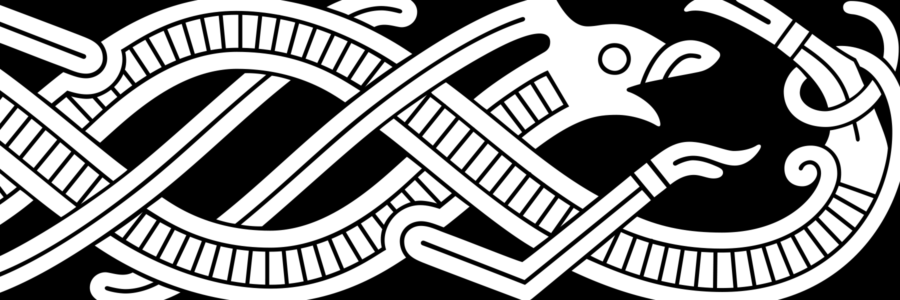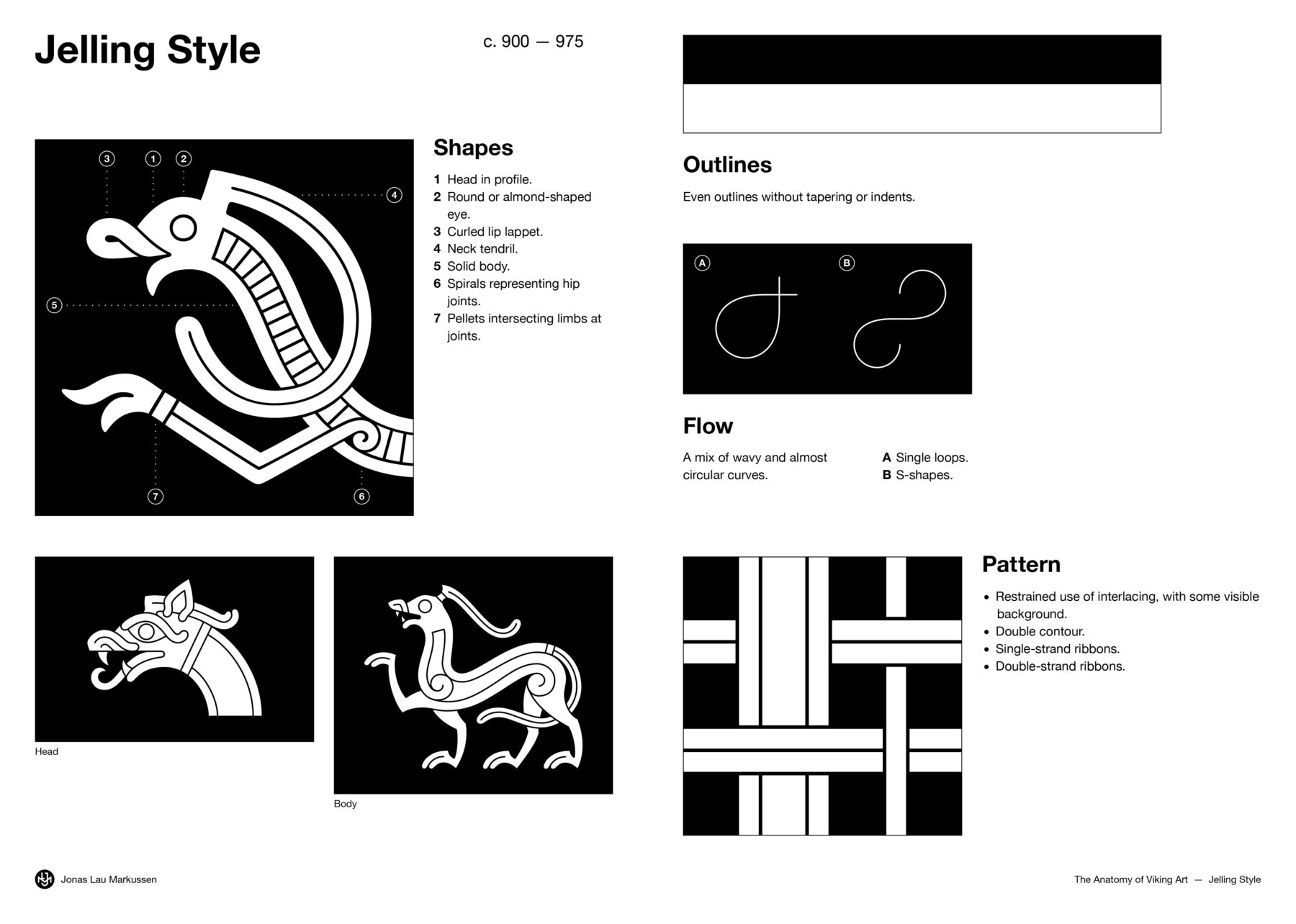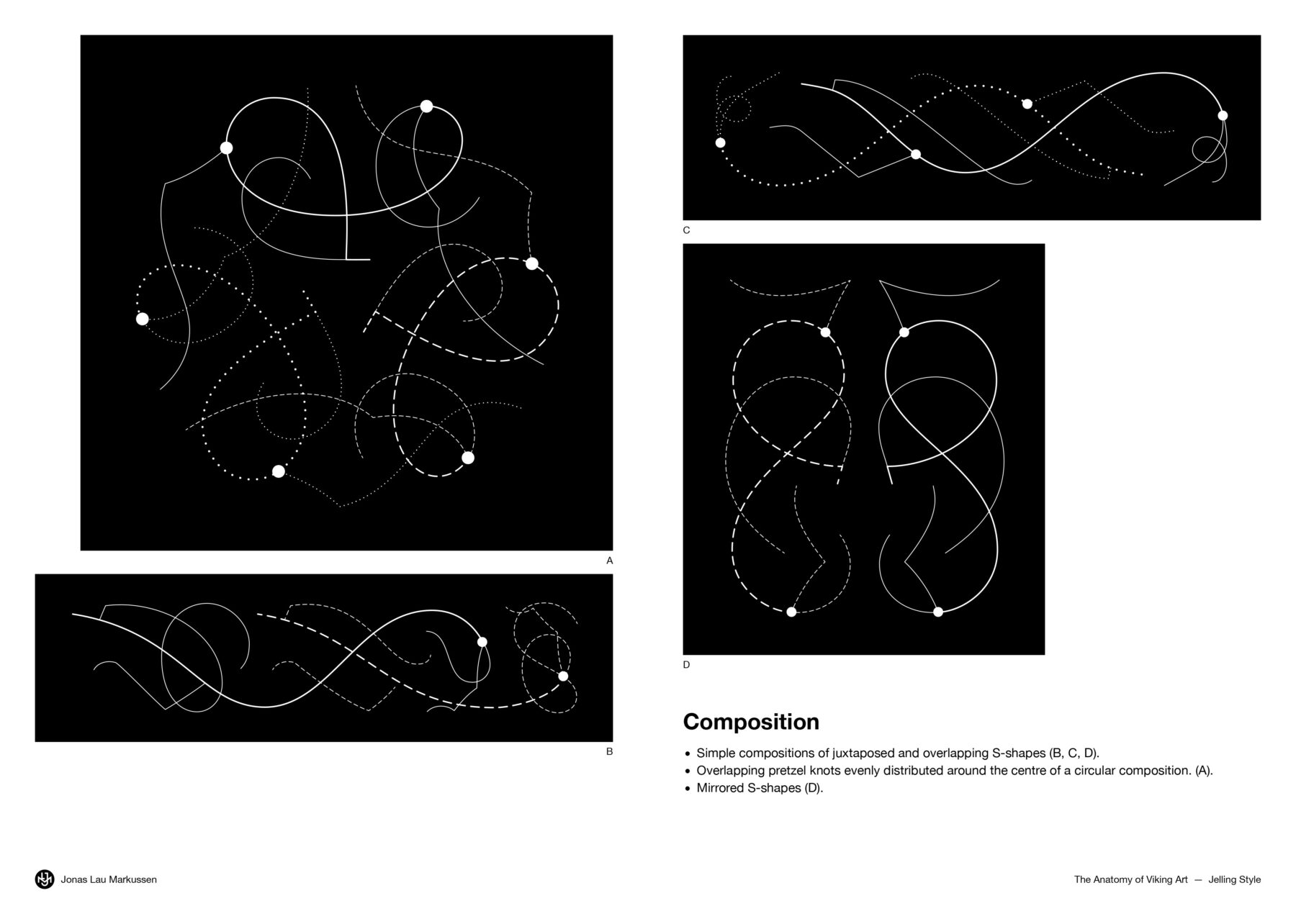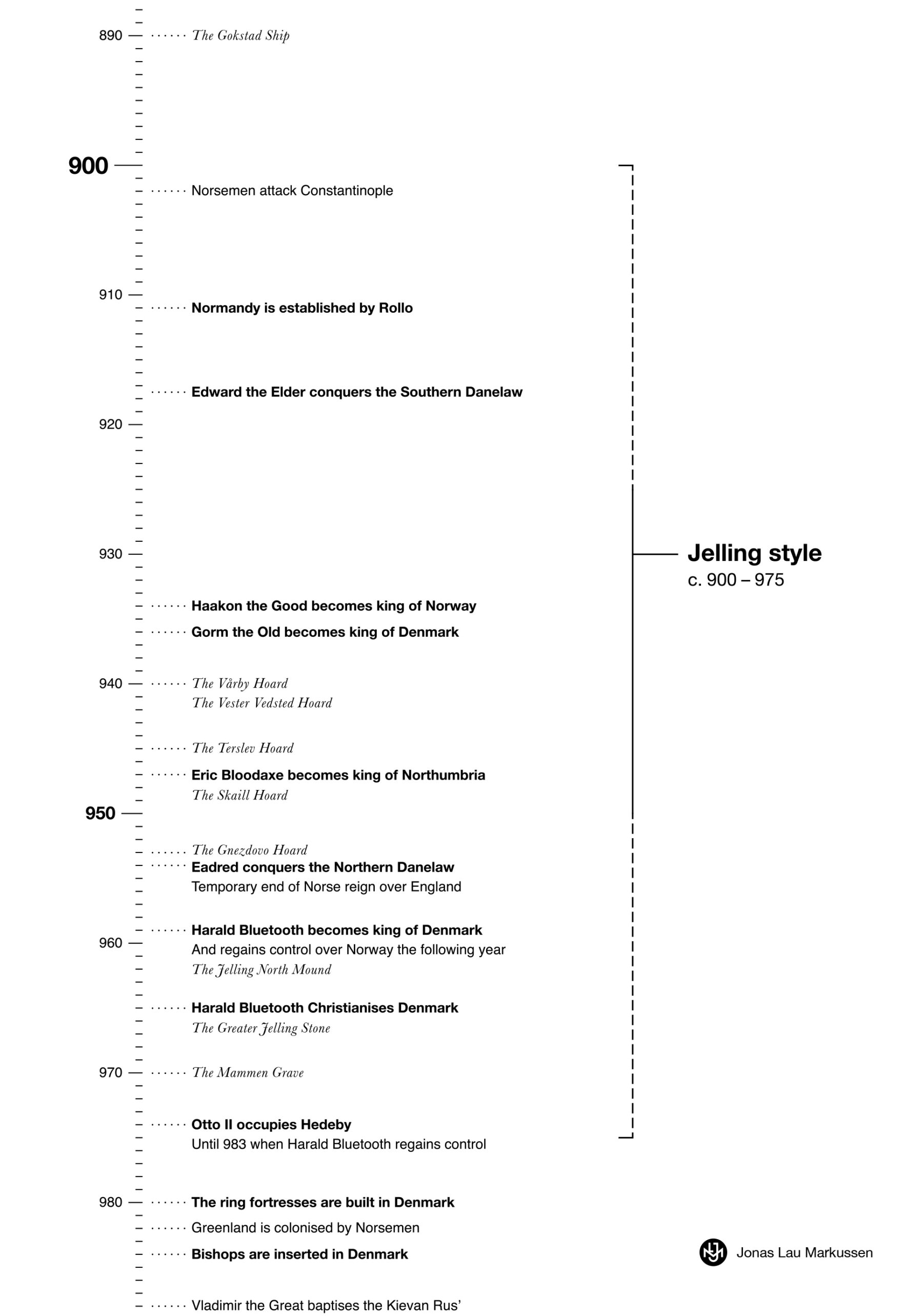
Jelling Style
December 20, 2016
The Anatomy of Viking Art
- Introduction
- Broa Style
- Oseberg Style
- Borre Style
- Jelling Style
- Mammen Style
- Ringerike Style
- Urnes Style
The Anatomy of the Jelling Style
c. 900 – 975
Shapes
1. Head in profile.
2. Round or almond-shaped eye.
3. Curled lip lappet.
4. Neck tendril.
5. Solid body.
6. Spirals representing hip joints.
7. Pellets intersecting limbs at joints.
Outlines
Even outlines without tapering or indents.
Flow
A mix of wavy and almost circular curves.
A. Single loops.
B. S-shapes.
Pattern
- Restrained use of interlacing, with some visible background.
- Double contour.
- Single-strand ribbons.
- Double-strand ribbons.
Composition
- Simple compositions of juxtaposed and overlapping S-shapes (B, C, D).
- Overlapping pretzel knots evenly distributed around the centre of a circular composition. (A).
- Mirrored S-shapes (D).
Motifs
- Ribbon animals, typically with striated bodies.
Rise of the Jelling Dynasty
English Control of the Danelaw
The Anglo-Saxon King Edward the Elder managed to take back most of the Danelaw except Northumbria, which remained under Norse rule. A few years later his son Eadred finally managed to gain control over and absorb Northumbria into the English Kingdom after the death of King Eric Bloodaxe, and in doing so ended the Norse reign in English territory.
The Jelling Dynasty
Power in Denmark began to concentrate in and around the aristocracy of the Jelling area, on the Jutland peninsula. Gorm the Old is the first historically recognised king of Denmark. His wife Thyra is mentioned on a number of runestones in the Jelling area, particularly on the Lesser Jelling Stone, which Gorm raised in her memory. It is believed that when Gorm died, he was buried in the chamber of the North Mound in Jelling, built by his son and successor, Harald Bluetooth. However, Gorm’s remains were later moved from the mound to a final resting place under the wooden church built by Harald when he converted to Christianity.
The First Christian Norse King
After the death of Harald Fairhair, his son Haakon the Good returned to Norway to fight his half-brother, Eric Bloodaxe, over his claim to the throne. According to legend, Haakon was fostered by the Anglo-Saxon King Athelstan, son of Edward the Elder, as part of an agreement made with his father, Harald. In England, he was influenced by the Christian faith of the English people, which he brought back with him to Norway. Haakon gained the support of the Norwegian landowners by promising to cede the right to tax them claimed by his father. With his new-found support, he was able to force Eric to flee to the British Isles, where he eventually would be King of Northumbria for a few years before his death. Haakon later fought and was eventually defeated by Eric’s sons, supported by Gorm the Old.
Bishoprics in Scandinavia
Several of the trading towns such as Hedeby and Aarhus became the seat of a bishop under the Archbishopric of Hamburg and Bremen.
The Holy Roman Empire
Following the death of Emperor Louis the Pious, the Frankish Empire was divided in three: West Francia, Middle Francia and East Francia. No emperor was appointed in the West for several years, until the crowning of the Saxon king, Otto I.
Return of the Ribbon Animal
Development
With the Jelling style begins a revival of the ribbon animal, eventually pushing the motif of the gripping beast into oblivion. Though often executed in fairly simple, juxtaposed and overlapping S-shaped layouts, and still drawing heavily on the highly geometric interlacing patterns of the preceding Borre style, such as the pretzel knot and chain patterns, the Jelling style is largely a return to the Norse traditions of animal ornament reminiscent of the Broa style, and even the earlier Germanic styles. The Jelling style ribbon animal was further developed in the subsequent styles, and various iterations continued to be in fashion right up to the end of the Viking Age. Compared to the subsequent iterations of the ribbon animal in the Mammen, Ringerike and Urnes styles, the anatomy of the Jelling animal is relatively simple and formalised, with its equal-width ribbon body, neck tendril and curly upper lip-lappet. All these components constitute the backbone of the style, and spill over into the subsequent styles, with the addition of their individual stylistic traits. And though the execution of the Jelling style may vary, and sometimes seem superficially unrelated, when one looks closer, the underlying structure is often revealed as strictly conventional. Thus, the style both pays tribute to the ribbon animal tradition of the past, and establishes the new tradition of future Norse animal ornament.
Disc Brooches and Circular Pendants
The early Jelling style is often found on disc brooches and circular pendants beside jewellery of approximately the same type, featuring Borre style decorations. The Jelling style designs often make use of Borre style compositional schemes, but instead of gripping beasts, they feature ribbon animals with their heads in profile, and neck tendrils.
The Jelling Cup
This style got its name from a small cup that displays two overlapping S-shaped ribbon animals, found in the burial chamber of the North Mound of the Jelling monument site, and it is believed to have been part of the grave goods that accompanied Gorm the Great after his death.
Horse-Harness Bows
The three horse-harness bows found in Mammen, Jutland and Søllested, Funen, display more elaborate and figurative ornaments, while featuring some of the Jelling style trademarks, such as the curled lip lappet and single neck tendril. They seem as though they may be later developments of this style, on the cusp of a transition into the Mammen style.
Distribution
Like the preceding Borre style, we find the Jelling style in all areas where the Norse went at the time, from the British Isles through Eastern and Western Europe. There was no widespread tradition of stone carving in Scandinavia at this time, but a few stone monuments on the British Isles and the Isle of Man display motifs that clearly derive from the contemporary Scandinavian style. The craftsmen of the British Isles already worked with animal patterns and interlacing, which made a mutual influence between the Anglo-Saxon style and the Scandinavian style very easy.
Examples
Examples on Gelmir.com →
A list of examples with photos, info and links to sources.
Dateable
c. 942 (youngest coin)
Disc brooch — the Vester Vedsted Hoard
Vester Vedsted, Jylland, Denmark.
Nationalmuseet, København, 18374-78, 18571-73, DNF 12/33.
c. 944 (youngest coin)
Pendants, ear and nail spoons — the Terslev hoard
Terslev, Sjælland, Danmark.
Nationalmuseet, København, DNF 33/11, 35/11, 40/11, 46/11, Dnf 33/11.
c. 945 – 946
The Skaill Hoard
Skaill, Orkney, Scotland.
National Museums Scotland.
c. 953 – 954
Pendants — the Gnezdovo Hoard
Gnezdovo, Smolensk, Rusland.
Gosudarstvennyj Ermitaž, Saint Petersburg 994
c. 958 – 959
Cup — the North Mound
Jelling, Jylland, Denmark.
Nationalmuseet, Købenahvn, CCCLXXII.
c. 958 – 959
Hinge fittings — the North Mound *
Jelling, Jylland, Denmark.
Nationalmuseet, Købenahvn, CCCLXXIV, DLXII.
c. 958 – 959
Bird-shaped strap mount — the North Mound *
Jelling, Jylland, Denmark.
Nationalmuseet, Købenahvn, CCCLXXIII.
c. 1016 (youngest coin)
Disc brooch — the Tråen Hoard
Tråen, Viken, Norway.
Kulturhistorisk Museum, Oslo, C21858.
Undateable
Animal-head strap mounts
Jelling, Jylland, Denmark.
Nationalmuseet, København, JL/301.
Box brooch — Fyrkat *
Fyrkat, Jylland, Denmark.
Nationalmuseet, København, D169/1966.
Box brooch — Nygårds *
Nygårds, Gotland, Sweden.
Historiska Museet, Stockholm, 449147.
Brooch *
Skovby, Falster, Denmark.
Nationalmuseet, København, Dnf. 26/32.
Die patrice
Mammen, Jylland, Denmark.
Nationalmuseet, Købanhavn C1067.
Hoard *
Fæsted, Jylland, Denmark.
Nationalmuseet, København, C42702; C42678; C42679; C42708; DNF90/11.
Horse-harness bow — Mammen
Mammen, Jylland, Denmark.
Nationalmuseet, København, C1063.
Horse-harness bow — Møllemosegård
Møllemosegård, Fyn, Denmark.
Nationalmuseet, København, NM MMCCXCIV.
Horse-harness bow — Søllested
Søllested, Lolland, Denmark.
Nationalmuseet, København, 25581.
Oval brooch
Morberg, Viken, Norway.
Kulturhistorisk Museum, Oslo, C21438.
Rectangular brooches
Erikstorp, Östergötland, Sweden.
Historiska Museet, Stockholm, 110904.
Round brooch — Erikstorp
Erikstorp, Östergötland, Sweden.
Historiska Museet, Stockholm, 109226.
Round brooch — Nonnebakken
Nonnebakken, Fyn, Denmark.
Nationalmuseet, København, C6271.
Strap end — Björkö
Björkö, Uppland, Sweden.
Historiska Museet, Stockholm, 449015.
Strap end — Gokstad
Gokstad, Vestfold og Telemark, Norway.
Kulturhistorisk Museum, Oslo, C24239.
Strap end — Gryta
Gryta, Møre og Romsdal, Norway.
Universitetsmuseet i Bergen, Bergen.
Strap end — Melvold Vestre *
Melvold Vestre, Viken, Norway.
Kulturhistorisk Museum, Oslo, C60634.
Tongue-shaped pendant
Björkö, Uppland, Sweden.
Historiska Museet, Stockholm, 107276.
Tongue-shaped mounts
Kornsá, A-Húnavatnssýsla, Iceland.
Þjóðminjasafn Íslands, Reykjavík, 1780/1880-6-7
Winged Figure
Uppåkra, Skåne, Sweden.
Historiska Museet, Lunds universitet.
* Examples added to the list in 2023.
Examples removed from the list in 2023
- Small disc brooch. Birka, Uppland, Sweden. Historiska Museet, Stockholm.
- Bronze scabbard-terminal mount. Astala i Kokemäki, Satakunta, Finland. Kansallismuseo, Helsinki 8338:39
Reclassified in 2023
- Gilt silver pendant. Vårby, Södermanland, Sweden. Historiska Museet, Stockholm, SHM 4516. → Borre style.
- Trefoil brooch. Blaker, Lom, Oppland, Norway. Universitetets Oldsakssamling, Oslo C6743. → Borre style.
Litterature
Graham-Campbell, James, 2013. Viking Art.
Fuglesang, Signe Horn, 1982. ‘Early Viking Art.’ Acta ad Archaeologiam et Artium Historiam Pertinentia (Series altera in 8°) 125–173.





